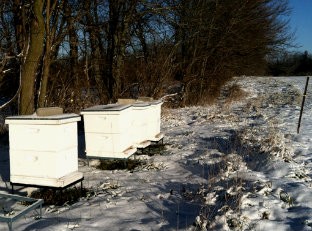The winter life of bees: Social order in the hive

On our small, diverse farms in central Illinois, walking aimlessly is a luxury reserved for the winter months, when the past season’s roller coaster has slowed almost to a stop and the new season’s marathon has yet to begin. At this quiet cusp of the seasons, there is ample time in the short days to hike through woods and over streams, and even more time to contemplate life, forward and back, during the long nights.
On one of January’s crisp, bright mornings, I went for a walk in the sparkling snow. I had no particular purpose in mind but knew, as Frost wrote, “how way leads on to way . . .”
Soon four beehives beckoned, their white paint gleaming almost as bright as the new snow around them. The hives are not ours but belong to a friend of a friend who needed organic farmland, safe from insecticides, on which to house them. We were glad to oblige, for the bees’ sake as well as the beekeeper’s—not to mention our own need for pollinators, without which there would be no cucumbers, beans, squash, tomatoes, okra, melons and much, much more. The deal did not need any sweetening, but still the beekeeper promised us a few half-gallon jugs of honey at season’s end.
Read our latest issue or browse back issues.
As I drew nearer to the hives, I remembered that the storm the day before had started as a slushy wintry mix that turned to ice before being covered by snow. I knew that the ice and snow could have easily sealed shut the small entrance in the mouse guard at the base of each hive.
In summer, the entire width of the hive is a takeoff and landing platform for squadrons of bees. But when the nights turn cold and mice are looking for spots to hunker down over the winter, that platform starts to look like the lobby of a five-star hotel—a warm and comfortable place with an endless supply of food. So to thwart the mice and protect the bees, we use the mouse guard, a narrow piece of wood with a small rectangular opening, to block most of the landing strip.
As I came closer, I saw that the first hive’s entrance was iced over, so I carefully unblocked the inch-long opening with my fingernails. Moving on to the next hive, I saw that its entrance was open, as was the next, and the next. But on that last hive’s landing board, I saw a half dozen bees. Like other insects, the honey bee is cold-blooded. When the temperature falls below about 50 degrees, it can no longer move. Paralyzed and unable to breathe, it dies.
Yet the entire hive of bees does not die off when the temperature falls. Although individual honeybees are ectothermic, maintaining body heat from outside sources, the hive collectively is endothermic, able to maintain body heat from within. A tight cluster of thousands of bees accomplishes this feat through highly choreographed wing-muscle contractions. All those bees pumping their wing muscles without flying produces heat in the same way that shivering helps warm our bodies on a frigid day. The cumulative effect of the bees “shivering” keeps the center of their hive tropical even when the mercury slips below zero.
But this heating can happen only when all the members of the hive are working together. An independent-minded bee in winter is a dead bee. And indeed, the bees near the hive entrance were frozen stiff, their delicately ice-encased legs and wings like those of Baltic insects caught in prehistoric amber.
These bees had not frozen because they were independent-minded, however. Honeybees have evolved a complex, instinctual, communal life in which independence plays no part. They died simply because bee lifespans are short—four to six weeks in the summer and four to six months in the winter. Some bees die naturally throughout the winter and are hauled out by their sisters on housecleaning days—which is any day that is over about 50 degrees and they can venture out safely.
When I bent down to examine the crystalline bees, I heard the unmistakable buzz of life from within the hive. I pressed my warm ear to the cold wood, and the decibels increased and instantly translated into a vision of their source: a basketball-sized cluster of vibrating bees, cut through at regular intervals by rectangular frames of honeycomb. At the center of the cluster was the elegant queen, surrounded by the first tight circle of bees, all heads pointed inward to feed and tend her, all basking in the 90-degree warmth. Moving out from the queen, the temperature declined, with the outer mantel of bees around 50 degrees—as low as a bee body can go without succumbing. All winter long, in the perfect social order of the hive, there is a constant rotation of cold bees to warm zones and warm bees to chilly zones—a sharing of the duties, pleasures and pains of communal life.
The cluster’s steady hum took me back to a summer’s day when the fallow field of red clover next to my brother’s vegetable field was alive with a hovering cloud of bees darting from flower to flower. The brutal heat and drought of the season had caused every living thing to struggle—plants, animals, humans and bees alike. Even one-tenth of an inch of rain was a blessing, and overnight it had prompted every scrawny clover plant to push up a flower. The bees had responded in force, their scouts telling the entire hive which direction to fly for the suddenly abundant nectar source. They ignored me as I strode bare-legged through their field, each worker intent on one thing only: bringing home her share of summer’s sweetness, the fuel the colony needs to survive the winter.
Now all those single-minded, hard-working summer bees were long gone, replaced by their winter sisters. Winter bees are different from summer bees, with larger bodies and a different hemolymph (the equivalent of blood) protein profile. The winter bees’ sole purpose is to keep themselves and, more important, their queen alive through the winter months. Then as soon as the weather warms, the queen starts laying eggs again, from which strong young worker bees emerge. When the nectar starts to flow from locust trees and dandelions, those bees fly out to begin laying up stores to get the next generation through the next winter.
The hum I was listening to, the soundtrack of my reverie, was those winter bees using the caloric energy gathered and stored up through the many bee-hours of the many bee-lives of their summer sisters. With a sudden pang I recalled the teaspoon of their precious fuel I had stirred into my cup of hot water and fresh-squeezed lemon scarcely an hour before. Depending on the length and severity of the winter, my sweet treat could cause them to come to a bitter end. The result of insufficient honey stores would be a silent springtime hive, full of thousands of lifeless bees, many of them buried head first in honeycomb cells where they looked in vain for the last lick of sustenance.
This vision set my mind marching forward and back, like the Spanish palindrome La ruta nos aportó otro paso natural—“The path provides the natural next step.” Was the next step to contact the beekeeper? Or go home and mix up some simple syrup to supplement the bees’ own stash of honey? Or would the natural next step be to let nature take its course?
I straightened up and looked around me. A hawk wheeled overhead in the bright blue sky, eyes laser-focused on any dark movement on the snowy field below. Mice and voles ran through their recently made snow tunnels. Small birds flitted through the nearby fence row and brush pile, looking for tiny fat-and-protein packets of seeds.
Turning my eyes back to the hives, I saw the frozen bees out on the snowy landing strip and imagined the warm bees buzzing inside. I saw the svelte, short-lived bees of summer and the burly, longer-lived bees of winter. I saw both the honey in the comb and the honey in my tea.
It all reminds me of Rilke’s koan-like statement: “It is our task to imprint this temporary, perishable earth into ourselves so deeply, so painfully and passionately, that its essence can rise again ‘invisibly,’ inside us. We are the bees of the invisible. We wildly collect the honey of the visible, to store it in the great golden hive of the invisible.”
I took a step back, but before I turned away I listened once more to the living bees humming and glanced once more at the crystal bees glistening. I felt a calm joy rising up as I said thank you to the visible and the invisible, the quick and the dead, and then I continued on my way.





